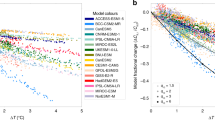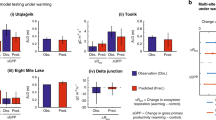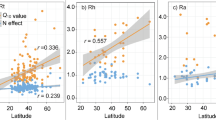Abstract
Davidson et al. question the validity of our conclusions on the grounds that differences in disturbance, high variability among sites, and the use of a single-pool model to estimate turnover time (TT) obscured the effect of temperature on the decomposition of soil carbon.
Similar content being viewed by others
Giardina and Ryan reply
In our comparison of incubated soils, disturbance associated with sieving and mixing probably increased decomposition rates. However, soil processing was similar across sites, and the resulting increase in carbon availability should have accentuated an effect of temperature on TT. In our in situ comparison, most tropical sites were pastures and all of the temperate sites were cropped. But these differences did not obscure an effect of temperature on TT. First, a subset of tropical sites had been continuously cultivated with sugar cane, which involves biannual mechanized ploughing, burning and fertilization. For sites that had been similarly disturbed after conversion from forest — that is, under intensive cultivation — TT tended to increase with mean annual temperature (MAT; R2 = 0.14, P = 0.07, n = 25). Second, tropical pastures are more severely disturbed than Davidson et al. suggest — bulldozers may be used to level a site and remove stumps, and mechanized disking is often used to control weeds1,2. Further, the effects of pasture conversion on carbon decomposition rates remain poorly understood2.
There are two ways to test whether we missed significance because of high variability. First, how important is site-to-site variability? And second, given our sample size, how much variation must temperature explain in order to be significant? For the incubation comparison, variation in TT was low (coefficient of variation, 37%), and TT actually increased with temperature (TT = 0.09 × MAT + 6.2). For the in situ comparison, time since conversion explained 34% of the variance in per cent carbon mass loss, a measure that assumes no model or age distribution of carbon in soil. With a sample size of 44 sites for the in situ comparison, MAT need only explain 8% of the variance to be significant at the 0.05 level. Given that MAT explained less than 1% of this variance, more than 1,000 sites would be needed to establish that there is a global relationship between temperature and soil carbon turnover.
We examined whether a single-pool model could obscure a temperature effect, and concluded that this is unlikely because our methods were robust1,3, the tests were independent and well replicated, and neither comparison showed the negative trends between TT and temperature that would be expected from modelled patterns of carbon mass loss across latitude4. We agree with Davidson et al. that only a small fraction of total soil carbon may be sensitive to temperature — this was our point.
Although the 14C approach preferred by Davidson et al . is useful for examining carbon turnover in soil, it has some methodological problems. For example, the 14C decay of interest begins at photosynthesis, not after incorporation into soil, as is now assumed1,5. In forests, this lag could affect estimates of soil-carbon TT that are based on 14C because carbon can reside in living biomass and the litter layer for decades before being released to mineral soil. The 14C approach is also sensitive to contamination3 and has yielded much faster estimates of soil-carbon turnover than more direct methods1.
Modelling terrestrial carbon storage depends on an accurate understanding of how temperature affects carbon TT in soil, but this effect cannot be inferred from large-scale relationships between soil-carbon content and MAT. Along gradients similar to those used by Jenny6 and cited by Davidson et al., plant primary production declines with increasing MAT, and it is this decline, not an increase in soil-carbon decomposition rate, that explains decreasing soil-carbon content with increasing temperature7. Similar findings have been reported8 for MAT gradients in northern Europe, and the gradient study cited by Davidson et al. actually reports9 longer carbon TT for tropical forest than for temperate forest. Despite the evidence against an exponential effect of temperature on soil carbon turnover, future in situ warming studies are needed to settle this issue.
References
Trumbore, S. E. et al. Glob. Biogeochem. Cycles 9, 515– 528 (1995).
Neill, C. & Davidson, E. in Carbon Pools and Dynamics in Tropical Ecosystems (eds Lal, R., Kimble, J. & Stewart, B.) 197–211 (CRC, Boca Raton, 2000).
Townsend, A. R., Vitousek, P. M. & Trumbore, S. E. Ecology 76, 721– 733 (1995).
Schimel, D. S. et al. Glob. Biogeochem. Cycles 8, 279– 293 (1994).
Trumbore, S. E., Chadwick, O. & Amundson, A. Science 272, 393– 396 (1996).
Jenny, H. Factors of Soil Formation (McGraw-Hill, New York, 1941 ).
Epstein, H. E., Burke, I. C. & Lauenroth, W. K. Ecology (in the press).
Liski, J. et al. Ambio 28, 171–174 (1999).
Raich, J. W. & Schlesinger, W. H. Tellus 44B, 81–99 (1992).
Author information
Authors and Affiliations
Rights and permissions
About this article
Cite this article
Giardina, C., Ryan, M. reply: Soil warming and organic carbon content. Nature 408, 790 (2000). https://doi.org/10.1038/35048675
Issue Date:
DOI: https://doi.org/10.1038/35048675
This article is cited by
-
Carbon sink and source function of Eastern Himalayan forests: implications of change in climate and biotic variables
Environmental Monitoring and Assessment (2023)
-
Characteristics of soil organic carbon and total nitrogen under various grassland types along a transect in a mountain-basin system in Xinjiang, China
Journal of Arid Land (2018)
-
Stabilization of new carbon inputs rather than old carbon decomposition determines soil organic carbon shifts following woody or herbaceous vegetation transitions
Plant and Soil (2016)
-
Stoichiometry of leaf nitrogen and phosphorus of grasslands of the Inner Mongolian and Qinghai‐Tibet Plateaus in relation to climatic variables and vegetation organization levels
Ecological Research (2016)
-
Changes to particulate versus mineral-associated soil carbon after 50 years of litter manipulation in forest and prairie experimental ecosystems
Biogeochemistry (2014)
Comments
By submitting a comment you agree to abide by our Terms and Community Guidelines. If you find something abusive or that does not comply with our terms or guidelines please flag it as inappropriate.



